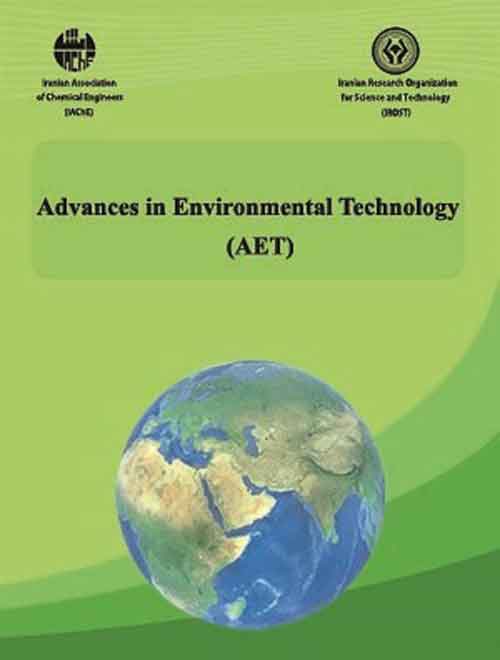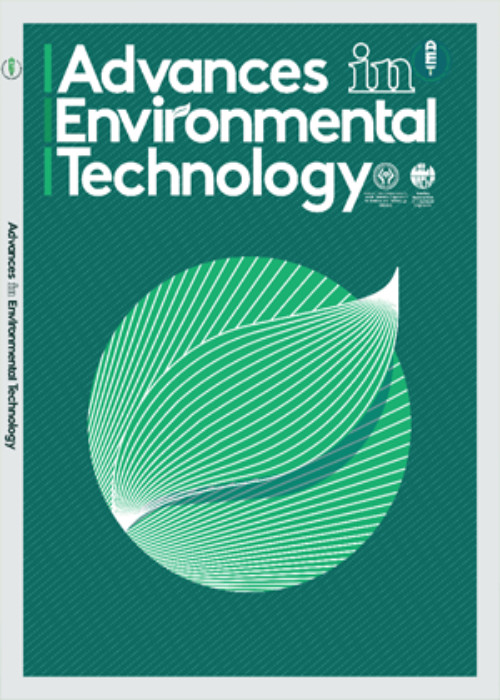فهرست مطالب

Advances in Environmental Technology
Volume:2 Issue: 4, Autumn 2016
- تاریخ انتشار: 1395/10/03
- تعداد عناوین: 6
-
-
Pages 169-177Dye-containing wastewater generated from textile industries is a major source of environmental pollution. Azo dyes, which are the largest group of coloring agents, are widely used in industries.
This research investigated the photocatalytic decolorization and degradation of an azo dye Reactive Red 198 (RR198) in aqueous solution with TiO2-P25 (Degussa) as photocatalyst in slurry form using UV light. There is a significant difference in adsorption of dye on TiO2 surface with the change in the solution pH. The effect of various parameters such as catalyst loading, pH and initial concentration of the dye on decolorization and degradation have been determined. The optimum conditions of the reactor were acquired at dye concentration = 62 ppm, pH = 3.7, catalyst concentration = 2.25 g.L-1, in which dye removal efficiency was 98%. Catalyst loading (relevant coefficient = 19.25) and pH (relevant coefficient = −2.62) were resulted respectively as the most and less effective parameters on dye removalKeywords: Photocatalytic degradation, Azo dyes, Reactive Red 198, TiO2, UV-light -
Pages 179-184A bioreactor refers to any manufactured or engineered device that supports a biologically active environment. These kinds of reactors are designed to treat wastewater treatment. Volumetric mass transfer coefficient and the effect of superficial gas velocity, as the most important operational factor on hydrodynamics, in three-phase airlift reactors are investigated in this study. The experiments for the external airlift reactor were carried out at a 0.14 downcomer to riser cross-sectional area ratio, and for the internal reactor at 0.36 and 1. Air and water were used as the gas and liquid phases, respectively, as well as activated carbon/sludge particles as the solid phase. Increasing the superficial gas velocity resulted in greater liquid circulation velocity, gas hold-up, and volumetric mass transfer coefficient; increasing the suspended activated carbon particles resulted in a decreased concentration of activated sludge, downcomer to riser cross sectional area ratio, liquid velocity, gas hold-up and volumetric mass transfer coefficient. The maximum gas hold-up was 0.178 which was attained in the external airlift reactor with a 1 Wt. % of activated sludge at a gas superficial velocity of 0.25 (m/s). The maximum volumetric mass transfer coefficient was 0.0485 (l/s) that was observed in the external airlift reactor containing activated carbon with a 0.00032 solid hold-up. A switch was observed in the activated sludge airlift reactor flow regime at gas velocities higher than 0.15 (m/s) and 0.18 (m/s) in the activated carbon airlift reactors.Keywords: Airlift Reactor, Activated Sludge, activated carbon, Mass transfer, Gas Superficial Velocity
-
Pages 185-195This paper presents the design and fabrication of proximity coupled feed disk resonator coated with Multi Walled Carbon Nanotubes (MWCNTs) and Polypyrrole-Chitosan (PPy-CHI) layers as a napropamide sensor. Computer Simulation Technology (CST) microwave studio was used to obtain the best design of disk resonator and feed line position in 5 GHz resonant frequency. Also, MWCNTs - PPy-CHI layers were coated on the disk resonator using electric field deposition and chemical interaction between sensing layer and napropamide was investigated by Fourier Transform Infrared Spectroscopy (FT-IR). The evaluation of the system was performed using different concentrations of commercial napropamide and pure napropamide at room temperature (25 0C). Experimental results prove that proximity coupled feed disk resonator coated with MWCNTs-PPy-CHI layers is a simple, fast (Measurement- time=5 seconds), accurate (as low as 0.1 ppm), low cost and it has the potential of fabrication as a portable instrumentation system for detecting pesticides in water and soil.Keywords: Napropamide sensor, carbon nanotube sensor, microwave sensor, Polypyrrole-Chitosan
-
Pages 197-205The interaction between the ions and the charge of membranes can affect the efficiency of pollutant removal. The present study investigated the removal efficiency of hexavalent chromium and nitrate ions from both actual and synthetic contaminated water via two different commercial spiral wound polyamide nanofilters. In addition, the interaction of ions under different experimental conditions was investigated by using a Box-Behnken design (BBD). The BoxBehnken design optimized the contributing factors which included pH (5-9), the initial concentration of Cr (VI) (0.05-5 mg/L) and the initial concentration of nitrate (40-160 mg/L). The maximum removal efficiency of both Cr (VI) and nitrate was achieved at a pH of 9.0, as 99 % and 90 % for the Iranian nanofilter (NF-I) and 98 % and 82 % for the Korean nanofilter (NF-K), respectively. The results also indicated that as the initial concentration of Cr (VI) increased, the removal efficiency was enhanced while the removal efficiency of nitrate decreased according to the pH. However, by increasing the initial concentration of nitrate, the removal efficiency of both the Cr (VI) and nitrate increased. For actual water samples at an optimum pressure of 0.6 Mpa (NF-K) and 0.8 Mpa (NF-I), the removal efficiency of Cr(VI) and nitrate obtained was 95% and 76 % for the NF-K and 97 % and 86 % for the NF-I, respectively.Keywords: Box–Behnken design, Hexavalent chromium, Ion interaction, Nanofiltration, Nitrate, Potable water treatment
-
Pages 207-214In this study, a lab-scale membrane bioreactor (MBR) was operated for a period of more than 10 months to determine the biokinetic coefficients of the system under the hydraulic retention times (HRT) of 20, 15 and 10 hrs and sludge retention times (SRT) of 5-20 days. The results revealed that the biological removal efficiency of styrene and ethylbenzene at a solid retention time of 20 day and a hydraulic retention time of 15 hr was higher compared to a SRT of 10 day and at the same HRT. The results also showed that the yield (Y), the endogenous decay coefficient (kd), the maximum specific growth rate (μmax), and the saturation constant (Ks) for styrene and ethylbenzene as substrate were 0.60 and 0.60 mg/mg, 0.25 and 0.25 day−1, 0.188 and 0.363 h-1, and 0.146 and 2.82 mg /l, respectively. Furthermore, ethylbenzene was more appropriate as a source of carbon to activated sludge in the membrane bioreactor than the styrene which had a lower μmax than ethylbenzene.Keywords: Biokinetic coefficient, Hydraulic retention time, Solid retention time, Volatile organic compounds
-
Pages 215-227The aim of this study was to evaluate the adsorption capacity of the novel coated activated carbon by chitosan for removal of Cr (VI) and Cd (II) ions from single and bi-solute dilute aqueous solutions. In addition, the adsorption abilities of activated carbon (AC), chitosan (CH) and chitosan / activated carbon composite (CHAC) have been compared. Adsorption studies were performed in a batch system, and the effects of various operating parameters such as solution pH, particle size and the dose of adsorbent were considered for removal of Cr (VI) and Cd (II) by Taguchi method. Equilibrium experimental data were well fitted to Langmuir isotherm for single and bi-solute solutions. The adsorption capacities of AC and CH adsorbents have improved by synthesis CHAC composite. As it was expected, competitive adsorption of metal ions on the CHAC surface led to reducing the adsorption capacity from 90.9 mg g-1 to 41.94 mg g-1 for Cr (VI) and 52.63 mg g-1 to 30.21 mg g-1 for Cd (II) ions, respectively. The adsorption capacities for the metal solutionadsorbent systems are in the order Cr (VI) > Cd (II). The kinetic studies indicated that the adsorption process was best described by the pseudo-second-order kinetics for single and bi-solute solutions.Keywords: activated carbon, chitosan, Composite, Chromium, Cadmium


